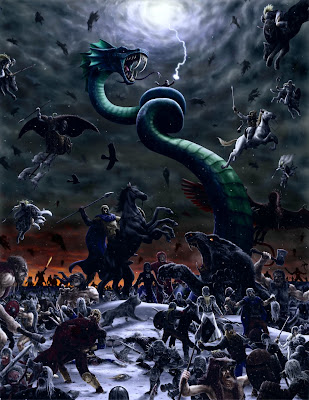 Norse myth can be regarded as one of the most ingrained mythological influences in our culture. It's creatures and heroes have provided inspiration to Tolkien, given life to many movies and games, and have even represent the names of the week while its poetry is where we have derived much of our modern prose from.Norse mythology was practiced by Viking pagans in modern day Norway, Sweden, Denmark, and Iceland before 1000 years ago. Its decline in popularity due to the coming of Christendom to Scandinavia in the 11th century greatly reduced its presence in Europe. Today, few reliable accounts of this mythology remain, such as the Heimskringla and the Prose Edda.
Norse myth can be regarded as one of the most ingrained mythological influences in our culture. It's creatures and heroes have provided inspiration to Tolkien, given life to many movies and games, and have even represent the names of the week while its poetry is where we have derived much of our modern prose from.Norse mythology was practiced by Viking pagans in modern day Norway, Sweden, Denmark, and Iceland before 1000 years ago. Its decline in popularity due to the coming of Christendom to Scandinavia in the 11th century greatly reduced its presence in Europe. Today, few reliable accounts of this mythology remain, such as the Heimskringla and the Prose Edda.Norse Myth dictates that creation of the world came from the collision of the ice ridden and fire wasted worlds of Niflheim and Muspelheim respectively, creating rivers which formed into the first Giants or Jotun.
Niflheim and Muspelheim colliding
Jotunheim, realm of the Giants Asgard, realm of the Gods

 The universe rests upon the great ash tree of Yggdrasil and nine worlds exist on Yggdrasil's branches. Asgard, home of the Æsir (the gods); Vanaheim, home of the Vanir (lesser gods); Alfheim, home of the light elves; Midgard, the "middle-earth," home to man; Jotunheim, home of the Rock and Frost Giants; Svartalfheim, home of the dark elves; Nidavellir, underground home to the dwarves; Niflheim and Hel, home of the dead; and Muspelheim, home to the Fire Giants.
The universe rests upon the great ash tree of Yggdrasil and nine worlds exist on Yggdrasil's branches. Asgard, home of the Æsir (the gods); Vanaheim, home of the Vanir (lesser gods); Alfheim, home of the light elves; Midgard, the "middle-earth," home to man; Jotunheim, home of the Rock and Frost Giants; Svartalfheim, home of the dark elves; Nidavellir, underground home to the dwarves; Niflheim and Hel, home of the dead; and Muspelheim, home to the Fire Giants. |
| Odin |
 |
| Loki |
One of the most distinguishing aspects of Norse Mythology is the detailed foretelling of Ragnarok, the end of the world and all of its inhabitants. It is written that harsh winters will last for many years and people will be driven to evil. Armies of the dead from Hel—led by the now-evil god, Loki—the Giants from Muspelheim and Jotunheim, and creatures like the hound, Fenrir, and the world serpent, Jormungandr, will all march against the Gods of Asgard. The Æsir, aided by 800 of the world's greatest warriors, will battle these foes on a great plain. Eventually, the world will be burnt to ash by fire and the sun and the moon will be engulfed by two enormous wolves. Yet after this destruction, a new world will be born from the ashes of the old, and a new sun and moon. Two people (Líf and Lífthrasir) had survived Ragnarok and it is them who will repopulate this new world with the knowledge of the old from the runes (stone inscriptions) left by the gods.
 |
| A Depiction of Ragnarok |
Further Reading on Norse Mythology

No comments:
Post a Comment